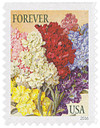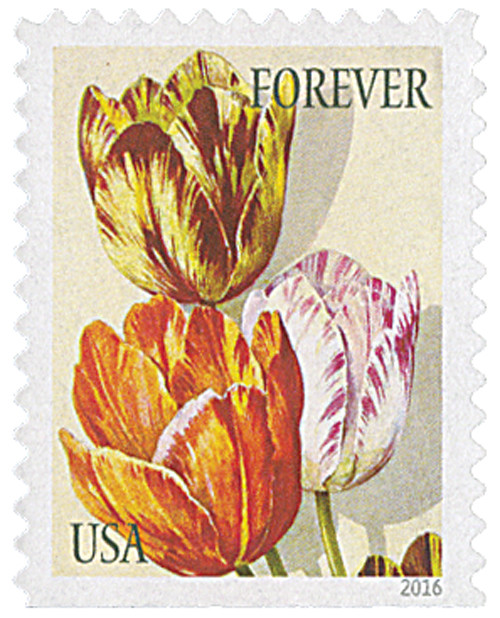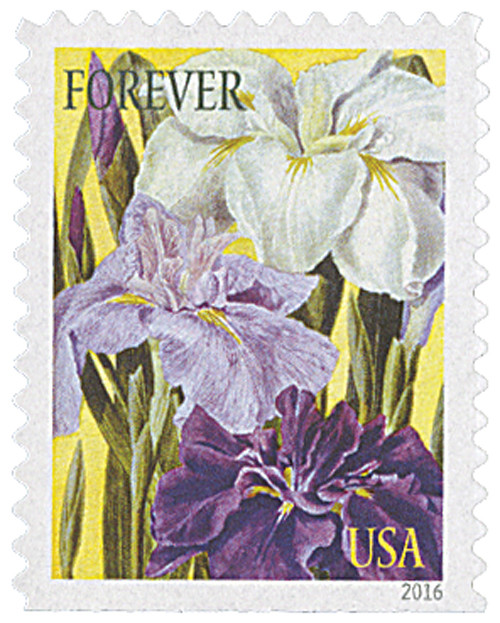
# 5046 - 2016 First-Class Forever Stamp - Botanical Art: Stocks
US #5046
2016 Stocks – Botanical Art
- Celebrates botanical artwork in American nursery catalogs printed between 1891 and 1912
Stamp Category: Definitive
Set: Botanical Art
Value: 49¢ First Class Mail Rate (Forever)
First Day of Issue: January 29, 2016
First Day City: Atlanta, Georgia
Quantity Issued: 60,000,000
Printed by: Ashton Potter
Printing Method: Offset
Format: Booklets of 10 OR Double-sided booklets of 20
Tagging: Nonphosphored type III, block tag applied
Why the stamp was issued: To continue the tradition of printing floral-themed US stamps.
About the stamp design: Pictures stocks from an American nursery catalog printed between 1891 and 1912. The catalog was from The New York Botanical Garden’s Nursery and Seed Catalog Collection.
First Day City: The First Day of Issue Ceremony was held at the American Philatelic Society’s AmeriStamp/Southeastern Stamp Expo. at the Hilton Atlanta in Atlanta, Georgia.
About the Botanical Art set: 10 stamps all picturing different artwork from a 100+ year old American nursery catalog. Species pictured include: corn lilies, tulips, dahlias, stocks, roses, Japanese irises, petunias, and jonquils.
History the stamp represents: Botanical illustration is the art of depicting the form, color, and details of plants. Often done in watercolor paintings, these works of art frequently accompany botanical descriptions in books and magazines. While they are beautiful, these illustrations arose out of necessity many years ago.
Early reference materials offered ways to identify plant species, which were usually for medicinal purposes. But accurately describing these plants across different cultures, growing regions, and languages was often challenging and dangerous.
The problem was solved in 512 AD with the earliest known illustrated botanical work. It was made for Anicia Juliana, the daughter of Roman Emperor Olybrius, who was an early patron of the arts.
Once plant classification became uniform in the 18th century, botanical illustrations ceased to be a necessity. However, advances in printing processes coincided with increasing interest in amateur gardening and natural history. This lead to expertly detailed botanical illustrations, which were widely used in guides, catalogs, and magazines of the period.
Today, skilled botanical illustrators create idealized images of several specimens. And they are able to depict details photographers cannot – helping to unlock the natural beauty of the plant world.
US #5046
2016 Stocks – Botanical Art
- Celebrates botanical artwork in American nursery catalogs printed between 1891 and 1912
Stamp Category: Definitive
Set: Botanical Art
Value: 49¢ First Class Mail Rate (Forever)
First Day of Issue: January 29, 2016
First Day City: Atlanta, Georgia
Quantity Issued: 60,000,000
Printed by: Ashton Potter
Printing Method: Offset
Format: Booklets of 10 OR Double-sided booklets of 20
Tagging: Nonphosphored type III, block tag applied
Why the stamp was issued: To continue the tradition of printing floral-themed US stamps.
About the stamp design: Pictures stocks from an American nursery catalog printed between 1891 and 1912. The catalog was from The New York Botanical Garden’s Nursery and Seed Catalog Collection.
First Day City: The First Day of Issue Ceremony was held at the American Philatelic Society’s AmeriStamp/Southeastern Stamp Expo. at the Hilton Atlanta in Atlanta, Georgia.
About the Botanical Art set: 10 stamps all picturing different artwork from a 100+ year old American nursery catalog. Species pictured include: corn lilies, tulips, dahlias, stocks, roses, Japanese irises, petunias, and jonquils.
History the stamp represents: Botanical illustration is the art of depicting the form, color, and details of plants. Often done in watercolor paintings, these works of art frequently accompany botanical descriptions in books and magazines. While they are beautiful, these illustrations arose out of necessity many years ago.
Early reference materials offered ways to identify plant species, which were usually for medicinal purposes. But accurately describing these plants across different cultures, growing regions, and languages was often challenging and dangerous.
The problem was solved in 512 AD with the earliest known illustrated botanical work. It was made for Anicia Juliana, the daughter of Roman Emperor Olybrius, who was an early patron of the arts.
Once plant classification became uniform in the 18th century, botanical illustrations ceased to be a necessity. However, advances in printing processes coincided with increasing interest in amateur gardening and natural history. This lead to expertly detailed botanical illustrations, which were widely used in guides, catalogs, and magazines of the period.
Today, skilled botanical illustrators create idealized images of several specimens. And they are able to depict details photographers cannot – helping to unlock the natural beauty of the plant world.














